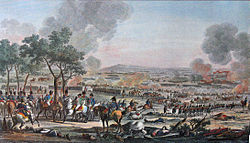Carle Vernet
This article has multiple issues. Please help improve it or discuss these issues on the talk page. (Learn how and when to remove these template messages)
|
Carle Vernet | |
|---|---|
Claude Joseph Vernet |
Antoine Charles Horace Vernet, better known as Carle Vernet (French pronunciation: [kaʁl vɛʁnɛ]; 14 August 1758 – 27 November 1836), was a French painter, the youngest child of Claude-Joseph Vernet and the father of Horace Vernet.
Biography

Vernet was born in
In his "Triumph of Aemilius Paulus", Vernet broke with tradition and drew the horse with the forms he had learnt from nature in stables and riding schools.
Carle's sister was executed by the guillotine during the Revolution. After this, he gave up art.

When he again began to produce under the
In addition to being a painter and lithographer, Carle Vernet was an avid horseman. Just days before his death at the age of seventy-eight, he was seen racing as if he were a sprightly young man.
Literary references
In
In Maria Wirtemberska's novel Malvina, or the Heart's Intuition (1816; English translation 2001, by Ursula Phillips), it is said that a view that is being described merits the talent of Vernet, who as the writer explains in her own footnote was a sea painter.
Selected works
-
Arrival of Emigres on the French Coast with theDuchess of Berry
-
AMamelukeLeading His Horse
-
Napoleon at the Battle of Borodino
-
Un Incroyable, two French dandies, one bearing what may be the first recorded top hat
See also
References
- ^ a b c d One or more of the preceding sentences incorporates text from a publication now in the public domain: Chisholm, Hugh, ed. (1911). "Vernet s.v. Antoine Charles Horace Vernet". Encyclopædia Britannica. Vol. 27 (11th ed.). Cambridge University Press. p. 1030.




